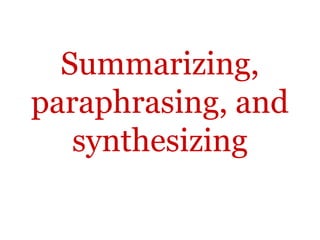
Summarizing, paraphrasing, synthesizing
- 1. Summarizing, paraphrasing, and synthesizing
- 2. Summarizing, paraphrasing, and synthesizing When working on an academic text it is likely that you are going to work with a variety of text. You will also need to select materials that are relevant for your work. Once you have selected the materials you want to work with, you need to make some adjustments before you can include them in your work.
- 3. Summarizing, paraphrasing, and synthesizing Before you can include other people’s ideas in your work you need to do one or more of these things: • Summarize • Paraphrase • Synthesize
- 4. Summarize • A summary is a shortened version of the original text. • It should contain the main points of the original text but in a condensed version. • It should be written in your own words. • The source should be acknowledged.
- 5. Points to help you summarize 1. Make sure you understand the original text. 2. Think about your purpose in using this text. What is your purpose in writing the summary? • Are you summarizing to support your point? or • Are you summarizing so you can criticize the work before you introduce your main points?
- 6. Points to help you summarize 3. Select the relevant information. This depends on your purpose. 4. Find the important ideas (words and phrases) and mark them in some way or list them elsewhere. • Distinguish between main and subsidiary information. • Delete most details, and examples, unimportant information, anecdotes, examples, illustrations, data, etc.
- 7. Points to help you summarize 5. Find synonyms or alternative phrases for those words. You do not need to change specialized vocabulary. 6. Change the structure of the text. This includes: • changing adjectives to adverbs and nouns to verbs • breaking up long sentences and combining short sentences • identifying the relationships between words and ideas and expressing them differently.
- 8. Points to help you summarize 7. After having completed the above steps, begin rewriting the main ideas in complete sentences combining your notes into a piece of continuous writing. Using conjunctions and adverbs such as ‘therefore’, ‘however’, although’, ‘since’, to show the connections between ideas. 8. Check your work.
- 9. Points to help you summarize When checking your work, make sure: • your purpose is clear • you have not copied any text (unless you are quoting) • you do not misinterpret the original • the length of your text is shorter • the style of writing is your own • you acknowledge other people’s work.
- 10. Paraphrasing Sometimes summarizing is not appropriate or relevant and you may want to maintain a closer link with the original but you do not want to quote word for word. In that case you may choose to paraphrase. It is a good idea to limit paraphrasing to short bits of text. You need to change the words and the structure of the original but keep the meaning the same. Again, when you paraphrase someone’s work you need to acknowledge it.
- 11. Points to help you paraphrase 1. Make sure you understand the original text. 2. Find the important ideas (words and phrases) and mark them in some way or list them elsewhere. 3. Finds synonyms or alternative phrases for those words. You do not need to change specialized vocabulary.
- 12. Points to help you paraphrase 4. Change the structure of the text. This includes: • Changing adjectives to adverbs and nouns to verbs • Breaking up long sentences and combining short sentences • Identifying the relationships between words and ideas and expressing them in a different way. (Be careful not to change the meaning.) 4. Once you have completed the above steps, rewrite the main ideas in complete sentences combining you notes into a piece of continuous writing.
- 13. Points to help you paraphrase 6. Check your work. When checking your work, make sure: • you have not copied any text • the meaning is the same as the original • the style of writing is your own • your paraphrase is the same length as the original • you acknowledge other people’s work through appropriate referencing.
- 14. Synthesizing When you synthesize you combine several texts into one, usually shorter, piece of writing. After you have selected the sources you want to use, you need to use your summary and paraphrasing skills to rewrite the information in your own words. The information from all the sources needs to fit together and form one continuous text. The sources need to be acknowledged and properly referenced.
- 15. Points to help you synthesize • All the points for summarizing and paraphrasing are relevant when you synthesize. However, the following point can be added to the summarizing points. • Organize the information you have from summarizing the different texts. You could give all the similar ideas in different texts the same number or color to help you group them together.